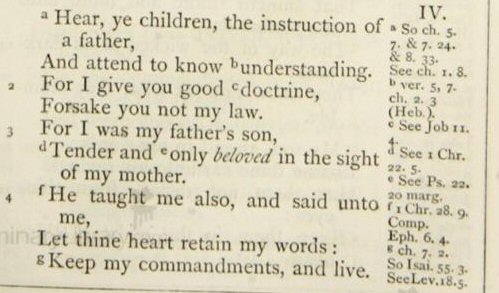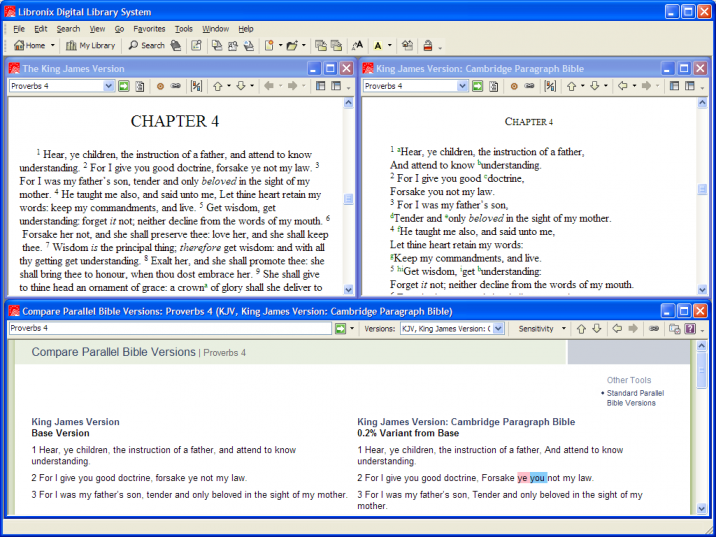Thoroughness is one of the hallmarks of electronic books produced for Logos Bible Software. When we produce an electronic edition of a printed book we try to include all of the content and every bit of relevant formatting. We also include detailed bibliographic information so that users can cite our electronic editions with confidence.
For this reason it always bothered me that our King James Version of the Bible – the textual patriarch of English-language Bible study – offered so little in the way of formatting, notes, and bibliographic detail. The KJV was our first electronic text, and while we have dozens of print copies, we produced our KJV from electronic sources.
In 1991, when we started working on Logos Bible Software, we purchased a disk set with the KJV text from Public Brand Software. It consisted of the text of the verses and nothing else, but it was adequate for our initial development and testing. Larry Pierce, who wrote The Online Bible, used this same text as the basis for his electronic KJV, but he hand corrected the files to match the 1769 Blayney Edition, published by Cambridge University Press, and added Strong’s numbers.
Larry’s text of the KJV was clearly the best available. Subsequent analysis has shown it to be error-free in its transcription of the Blayney Edition, and the addition of Strong’s numbers made it even more useful. With permission, we used it as the first electronic book released for Logos Bible Software.
Still, we got calls, letters, and emails from users who claimed it did not match their printed KJV. We discovered that, contrary to widely-held views, there is not one single text of the KJV. Almost no one is using (or even could use) the original 1611 text, and in the years since then there have been many intentional and unintentional typographic, editorial, and spelling changes propagated in hundreds of different editions.
Moreover, we did not even have a paper copy of the Blayney Edition we were distributing. Our electronic text was simply the Bible text, and we were missing front matter, notes, bibliographic information and more. While this isn’t a problem for Bible study, it is a problem for people comparing editions and preparing academic papers.
We went on a hunt for a definitive King James Version in print that we could reproduce completely, with all the bibliographic and supplementary material. We wanted a text with a clear pedigree and the smallest chance of errors introduced in multiple settings and printings.
After talking with publishers, Bible societies, and scholars, we concluded that the 1873 Cambridge Paragraph Bible, edited by F. H. A. Scrivener, was the best edition to use. More than a century after the Blayney Edition, Scrivener had done an incredibly comprehensive and careful revision of the KJV text. The text was paragraphed. Poetry was formatted in poetic form. Italics and cross references were thoroughly checked. Most importantly, Scrivener thoroughly documented his work. He noted errors in earlier editions and provided a “List of Passages in which this Edition follows others in departing from the Text of 1611.”
Scrivener’s edition of the text has been reprinted in later editions, but we wanted the whole thing, with all of the appendices and notes, straight from the original. So we began a year-long search for a printed copy that we could borrow long enough to photograph at high resolution using our robotic book scanner.
During our search, Cambridge University Press released A Textual History of the King James Bible, by David Norton. Norton’s book is a companion to the recently released New Cambridge Paragraph Bible, the latest and possibly most definitive KJV edition to date.
Norton’s book is an awe-inspiringly detailed look at the history of the text itself, and its preservation and corruption over the years. (I use the word corruption as a technical, not theological, term.) It reinforced for us the conclusion that identifying a definitive “real KJV” is nearly impossible. It also made it clear that nobody spent more time on the problem than Scrivener. (In explaining why no work was done on the cross references in his New Cambridge Paragraph Bible, Norton confesses to lacking Scrivener’s energy. If you read this book, you will confess to lacking the energy of either of them.)
We are trying to get permission to produce an electronic edition of the New Cambridge Paragraph Bible, but we believe that there is still value in having access to Scrivener’s monumental edition, complete with formatting, italics, cross references, introductions, apocrypha, and incredibly detailed appendices. So, when we finally found an 1873 original that we could borrow, we photographed it at high resolution and had it typed at 99.995% accuracy.
(We normally have books typed at 99.95% accuracy, which requires double-keying and comparing the files. We had the Cambridge Paragraph Bible checked to 99.995% accuracy, the highest level our vendor would guarantee.)
Our edition for the Libronix DLS is the most comprehensive and best documented KJV available electronically. The integration of the marginal notes and cross references into popup footnotes makes it easy to read. The Compare Parallel Bible Versions tool lets you compare the two KJV editions, and the ability to search appendices by Bible reference makes it easy to find Scrivener’s explanations for the different readings or spellings.
The 1769 Blayney and 1873 Cambridge editions side by side. The Cambridge features poetry formatting and notes. The comparison report below shows the single word difference in Proverbs 4.
The Libronix DLS-compatible Cambridge Paragraph Bible will be available with the release of Logos Bible Software 3. We will even have the page photographs available in the future.

The page image for Proverbs 4 in the 1873 Cambridge edition.





